Continue reading for our analysis...

Hawks are large, robust birds. Their powerful beaks are curved for biting and shredding flesh, and they have sharp, curved talons on their feet for catching food.
Several hawks are adept divers, reaching speeds of above 150 mph. Many species traverse hundreds of kilometers each year on their long migration treks, which is a testament to their fortitude and tenacity.
They have among the finest eyesight and hearing of any animal, as well as exceptional sensitivity. In addition to having better distant vision than humans, hawks have eight times as much visual acuity as we have.
Their vision can lead to some pretty impressive situations. Hawks are ferocious predators. They can see prey from a great height thanks to their superb vision. To capture rabbits, mice, lizards, fish, squirrels, or snakes, they descend from great heights.
They will occasionally sit on a tree or phone pole before swooping down to catch food.
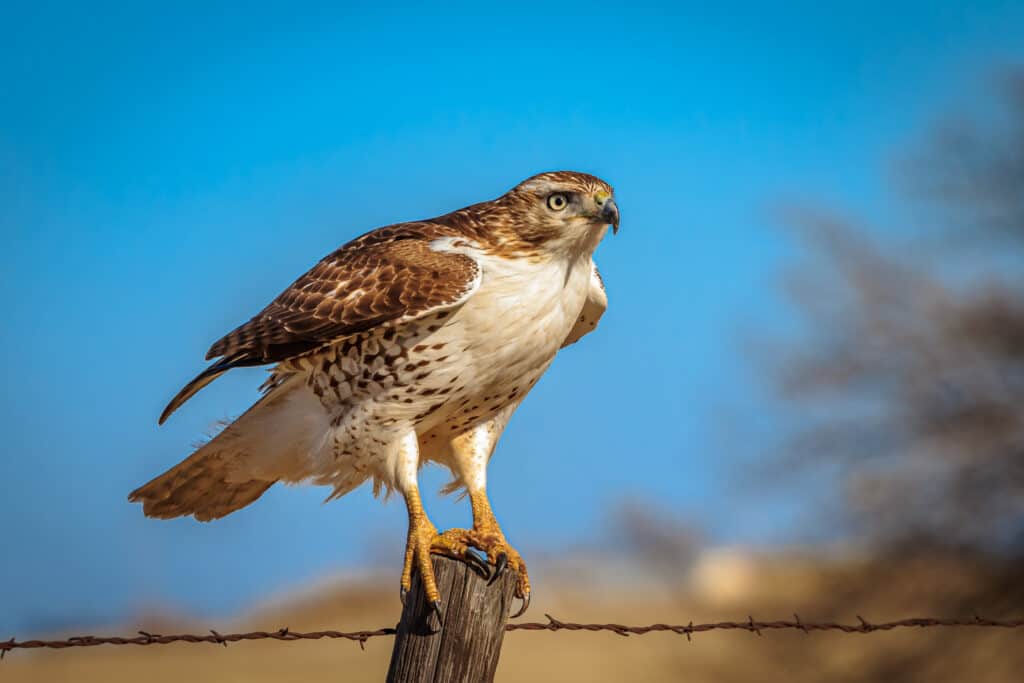
Hawk
©Richard G Smith/Shutterstock.com
A bird trainer filmed their trained hawk performing a jaw-dropping trick that could only be done with incredible vision. Sjors van de Wiel, a falconer with Topvogel, demonstrated how a spectacular Harris hawk with a huge wingspan is able to squeeze its wings in order to fit easily in narrow areas.
A short of the footage was uploaded to YouTube and has garnered over 30,000 likes at the time of writing this. It starts with two women with their foreheads pressed together, creating space between their bodies.
One of the women is laughing, while the other looks as scared as can be! We can see the bird trainer’s glove come into the frame as a hawk perfectly flies in between the small space between the ladies. They edited the video to show the hawk in slow motion, giving viewers an even better chance to see just how skilled this bird of prey truly is.
It takes on average seven years to become a Master falconer, including at least two years to complete your apprenticeship on your own. Each day, 365 days a year, a hawk needs a fair amount of time, and a bird in training needs a lot more time in the air. It’s no easy task to train a hawk and to do one with the precision seen in this video is impressive, to say the least.
Do you think you’d be able to calmly stand head-to-head with someone as a huge hawk flew in between you? It’s an intimidating idea but we here at AZA bet it felt exhilarating!
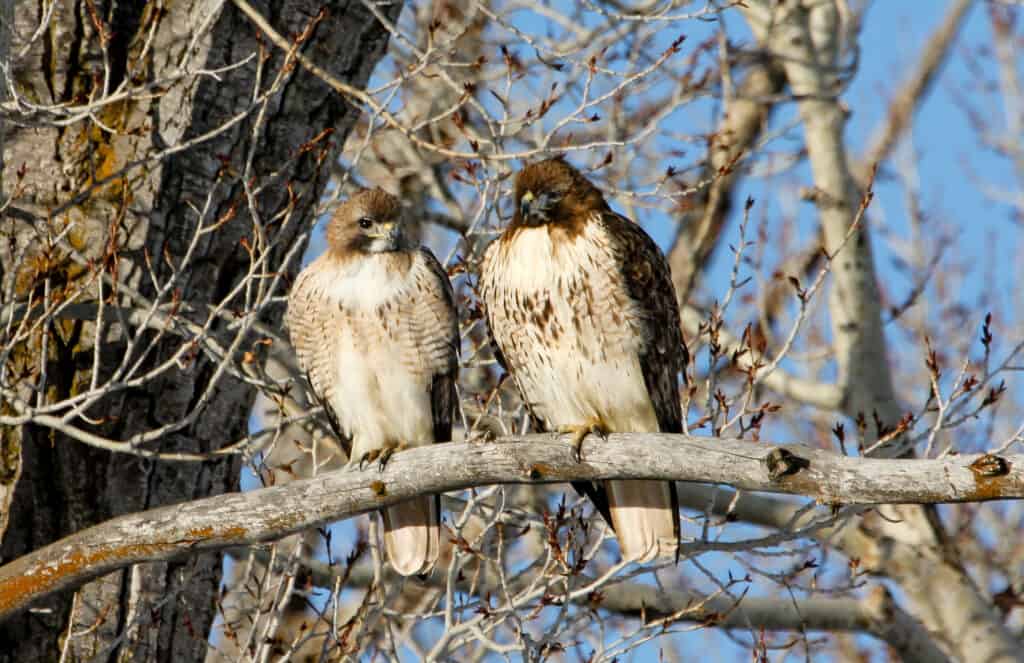
Most hawks are reddish-brown and grey with white feathers on their belly and chest and have a dark-colored beak. this is a red-tailed hawk.
©Ronnie Howard/Shutterstock.com
Would You Flinch if a Hawk Flew at Your Face?
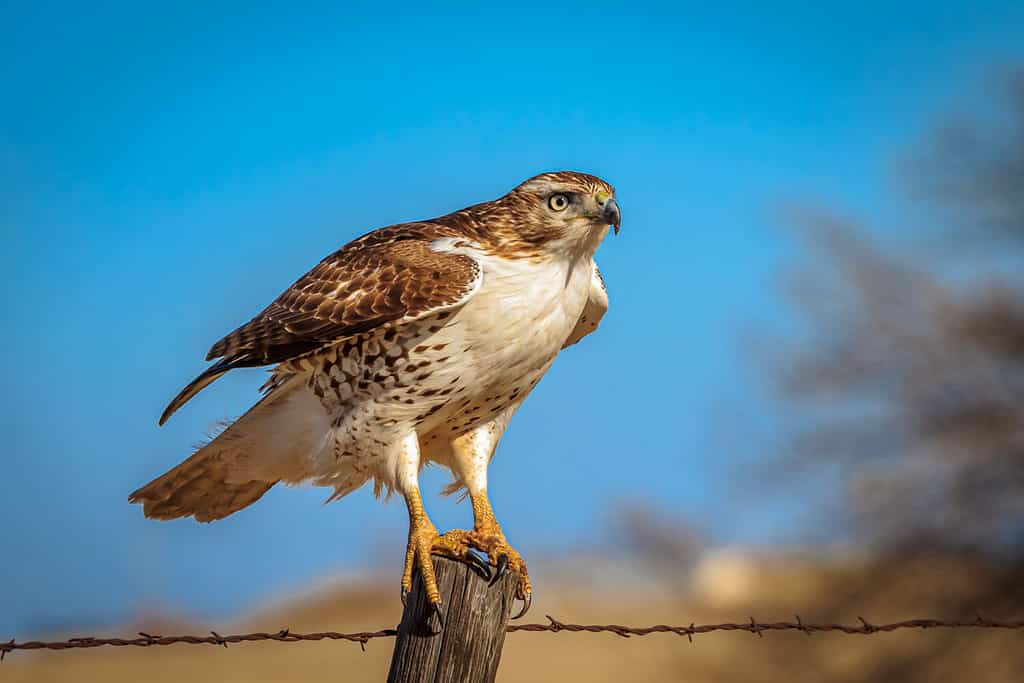
Falconers manage the flight of hawks by utilizing a blend of visual and auditory cues, such as whistling and walking in the desired direction to guide the hawk’s movement.
©Richard G Smith/Shutterstock.com
Falconers control hawks in flight with a combination of visual or oral signals including whistling and walking in the direction they wish the hawk to follow. It is imperative that the trained hawk remains in sight, even if it is high and distant, and preferable that it should be close enough to hear a shout or whistle.
The falconer in the video seems to have his hawk in complete control – resulting in an extremely high level of trust displayed by the two women helping with the training exercise.
How Precise is a Hawk While Flying?
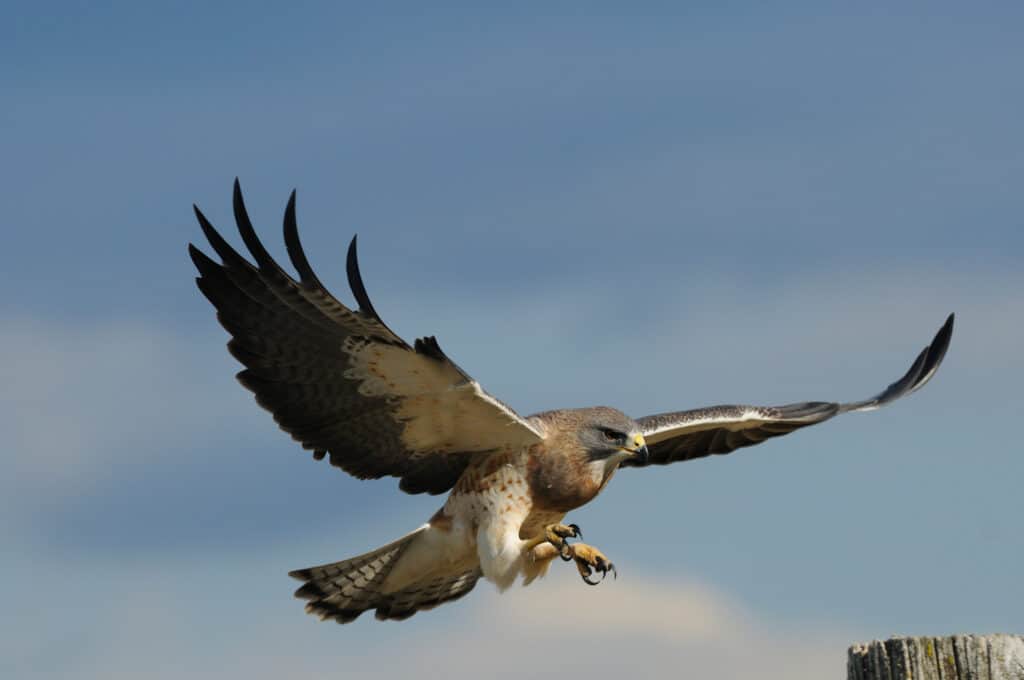
Swainson’s hawks are long-distance migrants, and almost the entire population moves from North America to South America during August and September.
©Rob McKay/Shutterstock.com
Hawks are known for their exceptional flying abilities, and they are particularly adept at maneuvering through the air with great precision.
Hawks are able to make sudden turns, sharp dives, and tight circles while hunting, allowing them to pursue and capture their prey with great accuracy. They can reach high speeds and make sudden stops, which allows them to catch prey by surprise. They can also fly at great heights and spot prey from far away.
Hawks are also able to hover in place, remaining perfectly still in the air while scanning the ground for prey. This ability allows them to focus in on a specific target, such as a small rodent or a bird, and strike with deadly accuracy.
Overall, hawks are incredibly precise while flying, and their hunting techniques are a testament to their agility and control in the air.
What Do Hawks Eat?
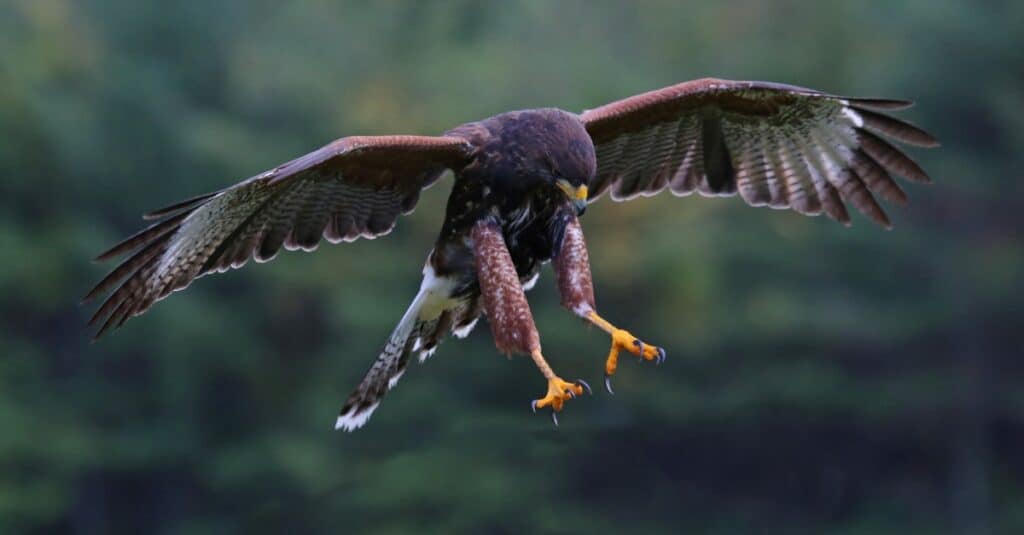
They typically eat other birds, small mammals such as rodents or rabbits, reptiles like snakes and lizards, fish, insects, and carrion.
©iStock.com/ca2hill
Hawks have quite a varied diet and tend to hunt for their food. They typically eat other birds, small mammals such as rodents or rabbits, reptiles like snakes and lizards, fish, insects, and carrion. Hawks use both sit-and-wait hunting techniques where they perch on a high place, looking for prey below them, or swoop down from the sky to grab their meal.
They can also use active hunting techniques where they search the ground in an attempt to flush out prey which is then caught midair. The type of prey they hunt depends on the size of the hawk. Smaller hawks usually opt for smaller animals, while larger hawks prefer larger creatures.
Where Do Hawks Live?

Hawks inhabiting forested areas generally favor expansive, fully-grown trees that offer shelter and suitable locations for nesting.
©Aussiemandias/Shutterstock.com
Hawks are found all over the world and can live in a variety of habitats, including:
- Forests: Hawks that live in forests typically prefer large, mature trees that provide cover and nesting sites. Some species of hawks that live in forests include Cooper’s hawk, the sharp-shinned hawk, and the northern goshawk.
- Deserts: Some species of hawks, such as Harris’s hawk and the red-tailed hawk, can live in deserts and other arid regions. They are able to survive in these environments by hunting small animals, such as lizards and rodents, that are adapted to living in the desert.
- Grasslands: Hawks that live in grasslands typically hunt small mammals, such as prairie dogs, and ground-nesting birds, such as meadowlarks. Some species of hawks that live in grasslands include the ferruginous hawk and the Swainson’s hawk.
- Coastal areas: Hawks that live in coastal areas typically hunt seabirds and marine mammals, such as seals and porpoises. Some species of hawks that live in coastal areas include the white-tailed hawk and the red-shouldered hawk.
- Urban areas: Hawks are also found in urban areas, they can be seen hunting pigeons, sparrows, and other city birds.
It is worth noting that each species of a hawk has its own specific habitat requirements and not all hawks will be found in all of these habitats.
Thank you for reading! Have some feedback for us? Contact the AZ Animals editorial team.







